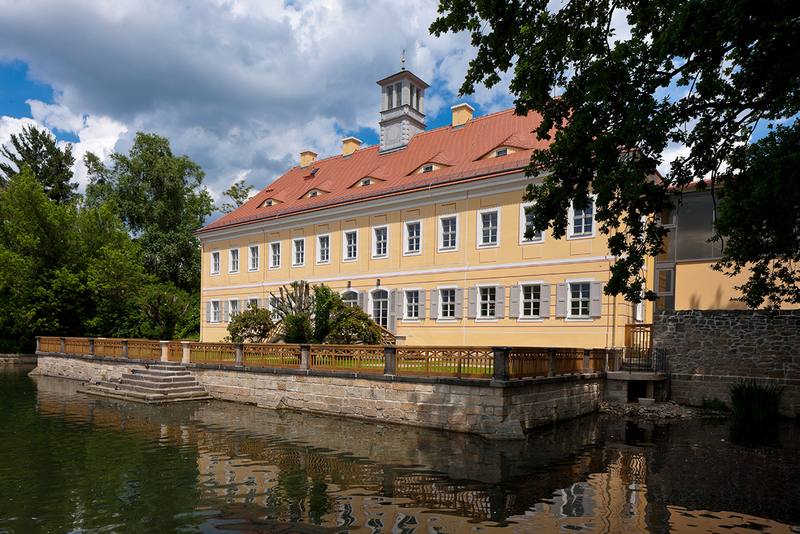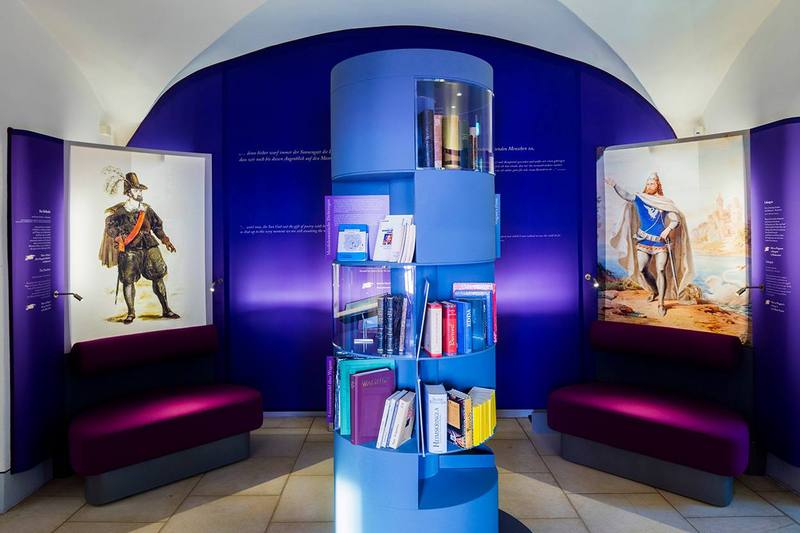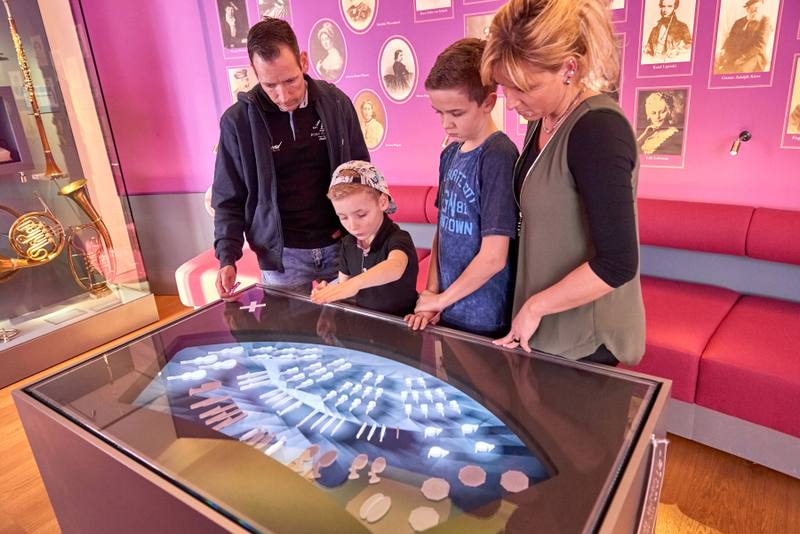Hunting Lodge Graupa
As soon as you enter the hunting lodge, musical sequences from Richard Wagner's operas greet you - an atmospheric welcome that sets the mood for the character of the museum. The color design of the museum in blue and purple tones is also atmospheric, which refers to the fact that Wagner was a highly emotional, lively man of the theater.
In terms of content, the focus of the presentation is on the years in Saxony up to 1849 – Wagner's childhood, youth and school days, as well as his years as a conductor in Dresden. Later stages of life and the impact of his work up to the present day are also highlighted.

Wagner in Saxony
Wagner was a Saxon. Born in Leipzig, he spent his childhood in Dresden, his youth and musical training in Leipzig and finally returned to Dresden in 1842. Here he became royal court conductor and premiered three of his operas. The fourth was denied him because of his participation in the 1849 revolution. He fled Dresden to avoid arrest.
Relevant themes of this period of life are presented in text and image, such as the family, teachers, members of the ensemble at the theater, revolutionary companions as well as places of life and work. A model of the Royal Court Theater, supplemented by the stage design for "Rienzi", forms the center of the room.

Museum multimedial – Inhalte in diesem Raum:
Poetry
The next rooms are dedicated to the complex creative process of Wagner‘s operas. It starts with the poetry. Richard Wagner was a librettist, composer, director, orchestra reformer and builder.
In the center of the room is a book tower, which, based on the "Dresden Library" (today in the Bayreuth Museum) shows librettos, Wagner's writings, literature about him and the sources of his opera texts. Books of fairy tales and sagas, linguistic and philosophical works, history and law books were just as much a part of this as works of the classics.
Cozy seating areas invite you to linger and browse. And those who don't want to read themselves have the opportunity to familiarize themselves with the text universe of Wagner's operas at the multimedia terminal. Special motif cards enable a targeted selection of themes, depending on whether one is more interested in love and hate or curse and redemption – themes that are omnipresent in Wagner's operas.
Museum multimedial – Inhalte in diesem Raum:
Composition
In this room, the focus is on the listening experience. As in the "Poetry" room, one can decide thematically to listen to music from Wagner's operas according to the chosen focal point. In addition, examples of music by Wagner's inspirers are presented. The topic "Berlioz-Liszt-Wagner – mutual influences" proves to be just as exciting as the consideration of the influences of Bellini, Weber, Marschner and Mendelssohn on Wagner. Multimedia terminals on aspects of compositional technique introduce the visitor to the secrets of Wagner's creative methods: leitmotif technique, the multicolored nature of the Wagner orchestra, orchestral preludes and interludes as agents of action and emotional guides.
Selected music samples from films that show Wagner's influence are equally exciting for Wagner and film fans alike. They go back to Hollywood in the 1930s.
In this room, children will once again find an information point specially designed for them. Here is shown how sheets of music were made in the past. Of course you can use this as a suggestion to make your own sheet of music by hand.
Multimedia – Content in this Room:
Theater & Stage
The holographic theater is technically and visually fascinating. You can directly experience the singing competition of the Norwegian sailors with the undead of the ghost ship from the opera "The Flying Dutchman". Furthermore, you can watch how the boy Gottfried, who was transformed into a swan in "Lohengrin", transforms back or you can join the journey of Wotan and Loge from the world of gods to the realm of the Nibelungen from "Rheingold". Wagner's music is combined with modern computer animation. Wagner would probably green with envy if he saw today's technical possibilities. At the time, he was considered as innovator of stage, which he revolutionized with his wealth of ideas.
Wagner's idea of optical arrangement in the performance of stage works had a lasting influence on stage practice. The art of effective scene changes plays a role, which directly influenced the structure of the compositions. Characters didn't just have to stand on stage, they had to fly, swim, become invisible, transform before the eyes of the audience. Stage sets had to change “as if by magic”.
The expansion of the orchestra in Wagner raises fundamental theatrical issues: balance between orchestra and singers, spatial limitations in the placement of performers, etc. How did Wagner resolve these issues and how are they resolved today? What were Wagner's directorial ideas? Wagner's opera works offer the opportunity to demonstrate the change in stage technology.
Museum multimedial – Inhalte in diesem Raum:
Orchestra Pit
Here the visitor stands in the orchestra pit himself – with a view of the theater stage and the auditorium. During his time in Dresden, the composer gained experience, particularly as a conductor, which he was later able to use in the conception of the Bayreuth Festspielhaus. The visitor chooses between different visualization modes, which graphically depict what is happening in the pit. A virtual score explains the leitmotifs.
Women, friends, patrons, companions, pupils and critics of Wagner fill the auditorium – and invite the visitor to take a seat and to start a virtual conversation.
Museum multimedial – Inhalte in diesem Raum:
Reception
The reception of Wagner began during his lifetime. Original documents, photographs and a multimedia terminal make it possible to experience the reception of Wagner from different times. The period of National Socialism and the instrumentalization of Wagner's music are not left out either.
Knick-knacks, arts and crafts, even a child's game show that Richard Wagner was used enterprisingly in his afterlife.
An information tower in the center of the room refers to the cities in which there are other authentic places where Wagner lived and which are used as museums – Eisenach, Leipzig, Tribschen near Lucerne and Bayreuth. It is an invitation to continue to follow Wagner's footsteps from Graupa.










